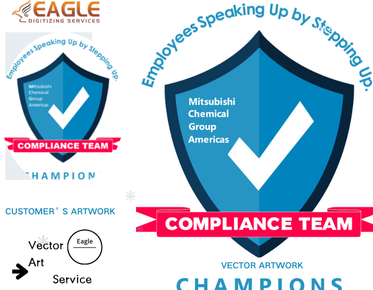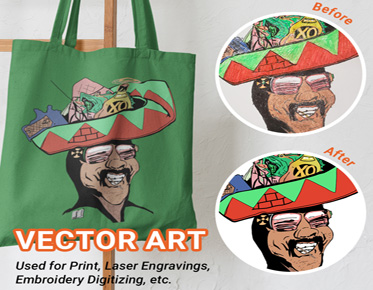What Sets Embroidery Digitizing and Vectorizing Apart? Find Out
In the world of digital design, the terms "digitizing" and "vectorizing" often surface, but they are not interchangeable. Understanding these processes is crucial for anyone involved in creating digital art or designs. This guide will unpack these concepts, exploring their distinct functions, benefits, and applications. By the end, you'll have a clearer grasp of when to use each method to maximize your design potential.
What Is Digitizing?
Defining Digitizing: The Basics Explained
Digitizing is the process of converting analog information into a digital format. This typically involves scanning physical artwork, photographs, or documents to create a digital image that can be edited, stored, and shared electronically. Unlike vectorizing, digitizing maintains the image in its original pixel-based format, known as raster graphics.
The Process of Digitizing: From Analog to Digital
The digitizing process begins with capturing the analog material using a scanner or camera. The captured image is then converted into a digital file, usually in formats like JPEG or PNG. This digital file can be manipulated in image editing software, but its resolution and quality are inherently tied to the original scan or photo.
Common Uses for Digitizing in Design and Art
Digitizing is often used for preserving artwork, creating digital archives, and enabling easy sharing and editing of physical art. It is ideal for converting detailed images or textures that benefit from high-resolution detail, such as historical documents, paintings, and intricate illustrations.
Tools and Technologies for Effective Digitizing
Effective digitizing requires a good-quality scanner or camera, image editing software like Adobe Photoshop or GIMP, and knowledge of file formats and resolution settings. High-resolution scans and color calibration are crucial for achieving accurate digital reproductions.
What Is Vectorizing?
Defining Vectorizing: The Core Concepts
Vectorizing, on the other hand, refers to the process of converting raster images into vector graphics. Unlike raster images, vector graphics are made up of paths defined by mathematical equations, which allows them to be infinitely scalable without loss of quality. This process involves creating shapes, lines, and curves that can be resized and manipulated with precision.
How Vectorizing Transforms Digital Art
Vectorizing transforms detailed pixel-based images into clean, scalable graphics that are ideal for various applications, from logos to complex illustrations. The result is a crisp, clear image that maintains its integrity regardless of size, making it perfect for print and digital use.
Applications of Vectorizing in Modern Design
Vector graphics are extensively used in branding, advertising, web design, and print media. Their scalability and precision make them suitable for logos, icons, and any design elements that require resizing without compromising quality.
Essential Tools and Software for Vectorizing
Popular vectorizing tools include Adobe Illustrator, CorelDRAW, and Inkscape. These software programs offer robust features for creating and editing vector graphics, including drawing tools, path editing, and color management.
Key Differences Between Digitizing and Vectorizing
Process Comparison: How Each Method Works
Digitizing involves capturing a physical image and converting it into a raster format, while vectorizing involves creating paths and shapes from an existing raster image. Digitizing retains the pixel-based structure, whereas vectorizing translates it into scalable vector paths.
Output Differences: Raster vs. Vector Graphics
Raster graphics, resulting from digitizing, are pixel-based and may lose quality when resized. Vector graphics, produced by vectorizing, are resolution-independent and maintain sharpness and clarity at any size. This makes vector graphics ideal for designs that require flexibility and precision.
Quality and Scalability: What You Need to Know
Raster images can lose quality when scaled up, resulting in pixelation. Vector graphics, however, can be resized infinitely without losing quality. This difference makes vector graphics preferable for designs that need to adapt to various sizes and formats.
File Formats: Understanding JPEGs, PNGs, and SVGs
JPEG and PNG are common raster file formats, with JPEG offering lossy compression and PNG providing lossless compression. SVG and EPS are popular vector formats, with SVG being widely used for web graphics and EPS for print. Understanding these formats helps in choosing the right file type for your project.
When to Use Digitizing
Best Scenarios for Digitizing Artwork
Digitizing is ideal for converting detailed or textured artwork, photographs, and documents into digital form. It’s useful for archiving, creating digital copies of physical art, or preparing images for online use.
Common Challenges and How to Overcome Them
Challenges in digitizing include resolution issues and color accuracy. To overcome these, use high-quality scanners or cameras and calibrate your equipment for accurate color reproduction. Adjusting image settings and editing in post-processing can also help address common issues.
The Role of Digitizing in Archiving and Restoration
Digitizing plays a crucial role in preserving and restoring historical documents and artwork. It allows for the creation of digital archives that can be accessed and analyzed without risking damage to the original pieces.
Examples of Successful Digitizing Projects
Successful digitizing projects include digitizing museum collections, historical manuscripts, and personal photo albums. These projects benefit from high-resolution scans and meticulous editing to ensure the digital reproductions accurately reflect the originals.
When to Use Vectorizing
Ideal Situations for Vectorizing Images
Vectorizing is best suited for designs that require scalability and precision, such as logos, icons, and illustrations. It is particularly useful for projects that will be used in various sizes and formats, ensuring consistency and clarity.
Benefits of Vectorizing for Printing and Web Design
Vector graphics are perfect for both print and web design due to their scalability and resolution independence. They maintain sharpness and quality in any size, making them ideal for everything from business cards to billboards.
Challenges in Vectorizing and Solutions
Challenges in vectorizing include dealing with complex images and ensuring accuracy in path creation. Solutions involve using advanced vectorizing software and techniques, such as manual tracing and adjusting anchor points, to achieve precise results.
Case Studies: Effective Use of Vectorization
Effective vectorization examples include creating brand logos, designing scalable icons, and developing detailed illustrations. These projects benefit from the clean, scalable nature of vector graphics and demonstrate the versatility of vectorizing techniques.
The Process of Digitizing
Scanning and Capturing: The First Step in Digitizing
Digitizing begins with scanning or photographing the physical artwork. Ensure high resolution and proper lighting to capture detailed and accurate images. This initial step is crucial for creating high-quality digital files.
Converting to Digital Formats: Tools and Techniques
After capturing the image, convert it into a digital format using image editing software. Adjust settings like resolution, color balance, and contrast to enhance the image. Save the file in a suitable format, such as JPEG or PNG, for your intended use.
Editing and Enhancing Digitized Images
Editing involves adjusting the digitized image to correct any imperfections or enhance its appearance. Use tools to crop, adjust colors, and remove any artifacts from the scanning process. This step ensures the final digital image meets your quality standards.
Practical Tips for High-Quality Digitizing
To achieve high-quality digitizing, use high-resolution settings, calibrate your equipment, and carefully handle your original artwork. Ensure proper lighting and avoid any physical damage to the source material to maintain the integrity of your digitized images.
The Process of Vectorizing
Tracing and Creating Vectors: How It’s Done
Vectorizing involves tracing raster images to create vector paths. Use vector graphic software to manually or automatically trace shapes and lines, converting pixel-based images into scalable vector paths. This process creates clean and precise graphics that can be resized without losing quality.
Software Tools for Vectorizing: A Quick Guide
Key software tools for vectorizing include Adobe Illustrator, CorelDRAW, and Inkscape. These programs offer features for tracing, editing paths, and applying color, making it easier to create high-quality vector graphics from raster images.
Adjusting and Refining Vector Paths
Refine vector paths by adjusting anchor points, curves, and handles to achieve accuracy and smoothness. This step involves fine-tuning the vectorized image to ensure it closely matches the original design and meets your quality requirements.
Best Practices for Clean and Accurate Vector Art
To produce clean and accurate vector art, use precise tracing techniques, avoid unnecessary anchor points, and regularly preview your work. Maintain consistency inline weights and color application to ensure a professional and polished final result.
Comparing File Formats
Raster Formats: JPEG, PNG, and Their Uses
JPEG is a compressed raster format suitable for photographs and web images, while PNG offers lossless compression and transparency, making it ideal for graphics and images requiring high quality. Each format has its specific uses based on the nature of the image and its intended application.
Vector Formats: SVG, EPS, and Their Applications
SVG is a versatile vector format used for web graphics, providing scalability and high quality. EPS is commonly used in print design for its compatibility with various design software. Understanding these formats helps in selecting the appropriate one for your project needs.
Choosing the Right Format for Your Project
Select the format based on the requirements of your project, such as scalability, quality, and compatibility. For web use, SVG is often preferred for its scalability and performance, while JPEG and PNG are suitable for raster images. For print, EPS offers high quality and flexibility.
Impact on Design and Production
How Digitizing Affects Design Workflows
Digitizing integrates physical artwork into digital workflows, enabling easy editing, sharing, and archiving. It facilitates the transition from traditional to digital design processes, streamlining the creation and modification of artwork.
The Role of Vectorizing in High-Resolution Production
Vectorizing is crucial for high-resolution production, ensuring that designs maintain clarity and precision at any size. This is especially important for print media and large-scale graphics, where resolution and scalability are key factors.
Customization and Adaptability: Digitizing vs. Vectorizing
Digitizing allows for detailed digital reproductions of physical art, while vectorizing offers adaptability and scalability for various design applications. Both methods have their strengths and are chosen based on the specific needs of the project.
Common Misconceptions
Clearing Up Confusion: Digitizing and Vectorizing Myths
Common misconceptions include the belief that digitizing and vectorizing are interchangeable or that one method is universally superior. In reality, each process serves distinct purposes and is suited to different types of projects.
The Reality of Quality and Resolution Differences
Digitizing captures pixel-based images that can suffer from resolution issues, while vectorizing creates resolution-independent graphics that retain quality at any size. Understanding these differences helps in selecting the appropriate method for your design needs.
Understanding the Limits and Possibilities of Each Method
Digitizing is limited by the resolution and quality of the original scan, while vectorizing offers greater flexibility and scalability. Knowing the limits and possibilities of each method allows for better decision-making in digital design.
Digitizing and vectorizing are essential techniques in digital design, each serving distinct purposes and offering unique advantages. By understanding the differences and applications of these methods, you can make informed choices that enhance your creative projects. Embrace these techniques to fully realize your artistic vision and achieve optimal results in your digital designs. Should this post have fanned the flames of your interest in Embroidery Digitizing and you desire to delve deeper, don't hesitate to communicate with us.
.png)


